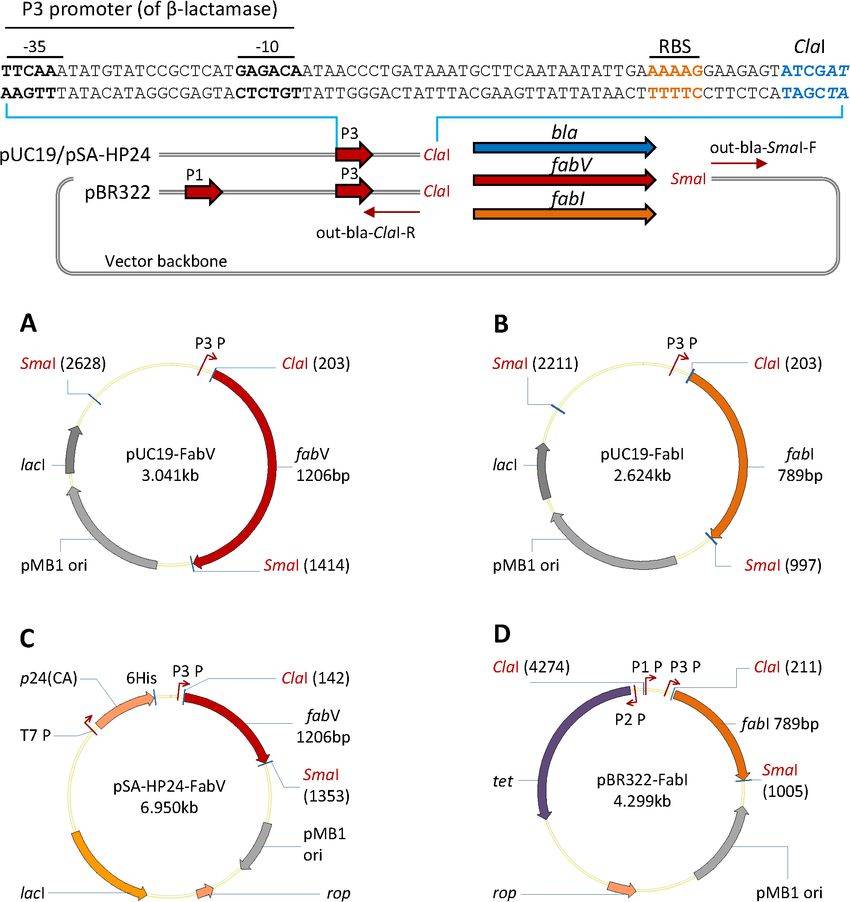Enzyme Gene and Plasmid Synthesis is a process in which specific genes, especially those encoding enzymes, are artificially created in a laboratory. In this process, the desired DNA sequence is designed and synthesized before being incorporated into a plasmid. The study of Enzyme Gene and Plasmid Synthesis is vital because it offers a controlled method to study enzyme function. It also allows for the production of the enzyme in large quantities for various applications, from research to industrial use. By synthesizing an enzyme gene, we can modify the gene to better fit clients' needs, potentially improving the enzyme's properties like its stability or activity. Additionally, gene and plasmid synthesis can be utilized in creating genetically modified organisms, developing gene therapies, and many other biotechnology applications.
 Construction of FabV and FabI-containing plasmid vectors (Syed A A. and Yik Wei C., 2015)
Construction of FabV and FabI-containing plasmid vectors (Syed A A. and Yik Wei C., 2015)
Technical Route
Our comprehensive technical route encompasses the following detailed steps:
| Step |
Objective |
Description |
| DNA sequence design and optimization |
Designing DNA sequence for enzyme gene |
The initial step involves designing the DNA sequence, optimizing it for expression and desired characteristics, ensuring functionality for specific needs. |
| DNA synthesis |
Synthesizing DNA sequence |
DNA sequence is synthesized in a controlled lab environment using precision techniques to ensure accuracy and consistency. |
| Ligation of DNA fragments |
Joining synthesized DNA fragments |
Synthesized DNA fragments are ligated together to form a full-length gene, providing a basis for further development. |
| Transformation into bacteria |
Introducing DNA into bacterial cells |
Ligated DNA is introduced into bacterial cells which serve as hosts, replicating the DNA to multiply the quantity of the target gene. |
| Plasmid extraction and purification |
Extracting and purifying plasmid |
Plasmid, carrying the gene of interest, is extracted from bacteria and purified to remove unwanted components, ensuring a pure gene product. |
| Sequence verification |
Ensuring DNA sequence accuracy |
Quality control measures are implemented to verify DNA sequence accuracy, ensuring it matches the original design and meets high standards for reliability. |
Service Process
Our service process is meticulously planned and executed, with the utmost attention to detail, to ensure the highest level of client satisfaction and product quality:
- Consultation and quote: We start with a detailed consultation to understand your needs and goals. This open communication helps us customize our services for you. Then, we provide a quote detailing our service costs.
- DNA Sequence Design and Optimization: Our expert scientists carefully design and optimize the enzyme gene's DNA sequence, ensuring its alignment with your objectives and effectiveness in your intended applications.
- Gene synthesis: The desired DNA sequence, perfected in the previous step, is assembled with complete precision using state-of-the-art techniques. Our team employs the latest advancements in technology to ensure accuracy and efficiency in this step.
- Cloning into plasmid: The synthesized gene is intricately incorporated into a suitable plasmid, a vital step that is executed with the utmost care to ensure the highest level of precision.
- Verification of sequence: Rigorous quality control measures are implemented at this stage. We employ stringent checks and balances, verifying the accuracy of the DNA sequence, to ensure that the final product aligns with the set requirements and standards.
- Delivery of Final Product: Our meticulously validated final product is promptly dispatched for immediate utilization in your applications. We take pride in our quick and secure delivery system that ensures the product's pristine condition.
We're here to assist you. If you have any questions, need more information, or would like to discuss a potential project, please don't hesitate to contact us. Our team is always eager to help and share our expertise.
Applications
| Application |
Description |
| Biotechnology |
Enzyme Gene and Plasmid Synthesis finds extensive application in biotechnology, enabling the production of recombinant enzymes for industrial processes, such as biofuel production, pharmaceutical synthesis, and bioremediation. |
| Molecular Biology |
In molecular biology research, Enzyme Gene and Plasmid Synthesis are crucial for studying gene expression, protein function, and genetic engineering. It facilitates the creation of custom gene constructs and expression vectors for various experimental purposes. |
| Genetic Engineering |
Enzyme Gene and Plasmid Synthesis are fundamental in genetic engineering applications, allowing the manipulation and expression of genes to produce desired proteins or modify biological pathways for research or industrial purposes. |
| Synthetic Biology |
Enzyme Gene and Plasmid Synthesis play a pivotal role in synthetic biology, where custom-designed genetic constructs and engineered plasmids are created to construct synthetic biological systems with desired functions or properties. |
| Pharmaceutical Development |
In pharmaceutical development, Enzyme Gene and Plasmid Synthesis are utilized for the production of therapeutic proteins, vaccine antigens, and gene therapies, facilitating the development of novel treatments for various diseases. |
| Medical Diagnostics |
Enzyme Gene and Plasmid Synthesis support medical diagnostics by providing the tools for the production of diagnostic enzymes, biomarkers, and molecular probes used in diagnostic assays for detecting diseases, monitoring treatment responses, and conducting genetic testing. |
| Agriculture and Food Science |
Enzyme Gene and Plasmid Synthesis contribute to advancements in agriculture and food science by enabling the development of genetically modified organisms (GMOs), novel enzymes for food processing, and biotechnological solutions for crop improvement and food safety. |
FAQs
Here are some commonly asked questions about Enzyme Gene and Plasmid Synthesis, along with their answers to provide a better understanding of the topic. If you have more specific or detailed questions, don't hesitate to get in touch with us directly.
Q: Why synthesize an enzyme gene?
A: Synthesizing an enzyme gene provides a controlled method of studying the function of the enzyme. It can also be a means to produce the enzyme in large quantities for industrial applications. By synthesizing an enzyme gene, researchers can tailor the gene to best suit their needs, potentially enhancing the enzyme's properties, such as increasing its stability or altering its activity.
Q: Can any enzyme gene be synthesized?
A: In theory, yes. The capability to synthesize any enzyme gene exists. However, the limiting factor is usually the length of the gene and the complexity of the DNA sequence. Longer and more complex genes require more time and resources to synthesize.
Q: What is the accuracy of gene synthesis?
A: With modern techniques, the accuracy of gene synthesis is extremely high. Sophisticated tools and stringent quality control processes often result in an accuracy rate reaching 99.99%. This high degree of accuracy is crucial in ensuring that the synthesized gene functions as intended.
Q: How long does it take to synthesize a gene?
A: The time it takes to synthesize a gene can vary greatly depending on the length and complexity of the DNA sequence. However, with the advances in technology and techniques, gene synthesis can typically be completed within a few days to a few weeks.
Q: What organisms can plasmids be introduced into?
A: Plasmids can be introduced into a variety of organisms. While they are most commonly associated with bacteria, plasmids can also be introduced into yeast and mammalian cells, amongst others. The choice of organism largely depends on the intended application.
Q: Can synthesized genes be expressed in any organism?
A: In theory, yes. However, the gene must be properly introduced into the organism, and the organism must have the necessary machinery to express the gene. Certain factors, such as compatibility of the genetic code and presence of necessary transcription and translation factors, will affect the successful expression of the gene.
Q: What are the applications of gene and plasmid synthesis?
A: The applications of gene and plasmid synthesis are vast and diverse. They include studying gene function, producing proteins for research or industrial purposes, creating genetically modified organisms, developing gene therapies, and much more. As our understanding and techniques improve, the potential applications continue to expand.
Q: What are the limitations of gene synthesis?
A: While gene synthesis is a powerful tool, it has its limitations. For example, synthesizing very large genes can be challenging and time-consuming. Also, certain complex DNA sequences might be difficult to synthesize accurately.
Q: How is the synthesized gene inserted into the plasmid?
A: The synthesized gene is inserted into the plasmid using a method called ligation, where the DNA sequence of the synthesized gene is joined to the DNA of the plasmid.
Q: Can the synthesized gene be modified?
A: Yes, the synthesized gene can be modified to include specific mutations or alterations, allowing researchers to study the effects of these changes.
Q: What is a vector in genetic engineering?
A: A vector is a DNA molecule used as a vehicle to artificially carry foreign genetic material into another cell. Plasmids are commonly used as vectors because of their ability to replicate independently.
Q: What safety measures are in place for gene and plasmid synthesis?
A: Gene and plasmid synthesis is done in a controlled laboratory environment, following strict safety and ethical guidelines. This includes measures to prevent contamination and ensure the safe handling and disposal of biological materials.

































 Construction of FabV and FabI-containing plasmid vectors (Syed A A. and Yik Wei C., 2015)
Construction of FabV and FabI-containing plasmid vectors (Syed A A. and Yik Wei C., 2015)